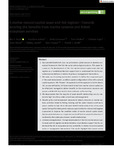A marine natural capital asset and risk register—Towards securing the benefits from marine systems and linked ecosystem services
| dc.contributor.author | Rees, Sian | |
| dc.contributor.author | Ashley, M | |
| dc.contributor.author | Cameron, A | |
| dc.contributor.author | Mullier, T | |
| dc.contributor.author | Ingle, C | |
| dc.contributor.author | Oates, J | |
| dc.contributor.author | Lannin, A | |
| dc.contributor.author | Hooper, T | |
| dc.contributor.author | Attrill, Martin | |
| dc.date.accessioned | 2022-03-11T14:24:44Z | |
| dc.date.available | 2022-03-11T14:24:44Z | |
| dc.date.issued | 2022-02-08 | |
| dc.identifier.issn | 0021-8901 | |
| dc.identifier.issn | 1365-2664 | |
| dc.identifier.uri | http://hdl.handle.net/10026.1/18941 | |
| dc.description.abstract |
<jats:title>Abstract</jats:title><jats:p> <jats:list> <jats:list-item><jats:p>Documented biodiversity loss has galvanised a global process to develop conceptual frameworks that link the social and ecological systems. This paper focusses on the development of the first marine natural capital asset and risk register as a foundational decision support tool to understand the risk to ecosystem service delivery in relation to policy or management interventions.</jats:p></jats:list-item> <jats:list-item><jats:p>We make use of existing marine data products to define the component parts of the asset status (extent, condition, spatial configuration) in line with a natural capital approach. We ‘Pioneer’ the application of this approach in North Devon, UK, an area defined by UK Government to test how marine natural capital can be effectively managed to deliver benefits to the environment, economy and people, and identify how best to share and scale up this learning.</jats:p></jats:list-item> <jats:list-item><jats:p>We demonstrate that the majority of asset–benefit relationships are at a medium to high risk of loss under current use and management.</jats:p></jats:list-item> <jats:list-item><jats:p>Despite policy and management measures to reduce pressures on marine systems, activities linked to fishing, farming and the water industry continue to pose a medium to high risk to the asset–benefit relationships. A lack of accurate spatial fishing effort data greatly reduces opportunities for rational and targeted approaches to improve the condition status of marine natural capital assets. Marine protected areas as a single tool are insufficient to prevent further loss of biodiversity that underpins all asset–benefit relationships.</jats:p></jats:list-item> <jats:list-item><jats:p><jats:italic>Synthesis and applications</jats:italic>. Through development of the first marine natural capital asset and risk register we demonstrates a novel decision support tool to understand the risk to ecosystem service availability in relation to environmental policy or management interventions. The results highlight that current marine governance strategies to protect biodiversity are not sufficient to reduce the risk of loss of ecosystem services. Wider application of the marine natural capital approach will require increasing confidence in the metrics to define marine asset status; more directed monitoring (extent and condition) and; greater accuracy in spatial fishing effort.</jats:p></jats:list-item> </jats:list> </jats:p> | |
| dc.format.extent | 1098-1109 | |
| dc.language | en | |
| dc.language.iso | en | |
| dc.publisher | Wiley | |
| dc.relation.uri | http://hdl.handle.net/10026.1/18563 | |
| dc.subject | ecosystem accounts | |
| dc.subject | ecosystem services | |
| dc.subject | marine protected areas | |
| dc.subject | marine spatial planning | |
| dc.subject | natural capital | |
| dc.subject | risk | |
| dc.title | A marine natural capital asset and risk register—Towards securing the benefits from marine systems and linked ecosystem services | |
| dc.type | journal-article | |
| dc.type | Journal Article | |
| plymouth.author-url | https://www.webofscience.com/api/gateway?GWVersion=2&SrcApp=PARTNER_APP&SrcAuth=LinksAMR&KeyUT=WOS:000762576000001&DestLinkType=FullRecord&DestApp=ALL_WOS&UsrCustomerID=11bb513d99f797142bcfeffcc58ea008 | |
| plymouth.issue | 4 | |
| plymouth.volume | 59 | |
| plymouth.publication-status | Published | |
| plymouth.journal | Journal of Applied Ecology | |
| dc.identifier.doi | 10.1111/1365-2664.14121 | |
| plymouth.organisational-group | /Plymouth | |
| plymouth.organisational-group | /Plymouth/Faculty of Science and Engineering | |
| plymouth.organisational-group | /Plymouth/Faculty of Science and Engineering/School of Biological and Marine Sciences | |
| plymouth.organisational-group | /Plymouth/PRIMaRE Publications | |
| plymouth.organisational-group | /Plymouth/REF 2021 Researchers by UoA | |
| plymouth.organisational-group | /Plymouth/REF 2021 Researchers by UoA/UoA07 Earth Systems and Environmental Sciences | |
| plymouth.organisational-group | /Plymouth/REF 2021 Researchers by UoA/UoA14 Geography and Environmental Studies | |
| plymouth.organisational-group | /Plymouth/Users by role | |
| plymouth.organisational-group | /Plymouth/Users by role/Academics | |
| dcterms.dateAccepted | 2022-01-06 | |
| dc.rights.embargodate | 2022-3-12 | |
| dc.identifier.eissn | 1365-2664 | |
| dc.rights.embargoperiod | Not known | |
| rioxxterms.funder | Natural Environment Research Council | |
| rioxxterms.identifier.project | South West Partnership for Environment and Economic Prosperity (SWEEP) | |
| rioxxterms.versionofrecord | 10.1111/1365-2664.14121 | |
| rioxxterms.licenseref.uri | http://www.rioxx.net/licenses/all-rights-reserved | |
| rioxxterms.licenseref.startdate | 2022-02-08 | |
| rioxxterms.type | Journal Article/Review | |
| plymouth.funder | South West Partnership for Environment and Economic Prosperity (SWEEP)::Natural Environment Research Council |


